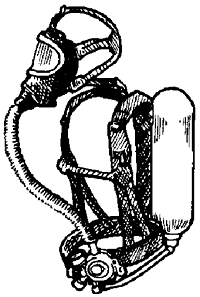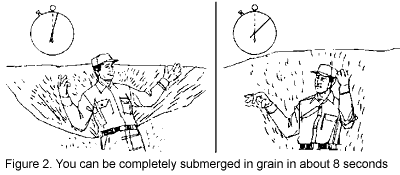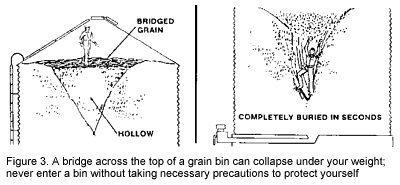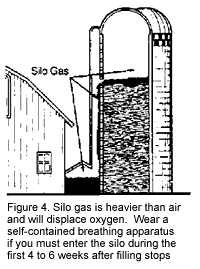Today's modern farming methods have brought new dangers that arise from farmers entering confined areas where oxygen levels may be inadequate or where toxic gases are present. When entering a confined area such as a manure pit, silo, grain bin, or an inadequately ventilated building a farmer may be at risk of being overcome by gases or dusts which can cause permanent lung damage or death.
Gases in manure pits and silos can quickly kill an unsuspecting farmer or an untrained rescue worker who enters the area without adequate protective equipment. Farmers entering grain bins while the bin is being emptied may be taking an unnecessary risk of being crushed or suffocated by flowing grain. Working in grain bins without proper respiratory equipment to filter dusts and molds increases a farmer's chances of developing a respiratory disease. Farmers working in dust-laden buildings run the risk of developing Farmer's Lung, a disease that permanently damages lung functions.
While most farmers are aware of the dangers of poisonous gases and flowing grain hazards, statistics from the past four years show that three to five Michigan farmers are killed each year in accidents involving these hazards. The occurrence of respiratory diseases among farmers cannot be accurately measured, but they are a concern among the rural population.
The intent of this publication is to make the reader aware of the risks associated with entering a confined space area and to provide information about risk reduction techniques for farm and orchard owners.
CHARACTERISTICS OF GASES
Hydrogen sulfide (H2S) is formed during manure decomposition. It is toxic, combustible, and because it is heavier than air, it dissipates oxygen and can suffocate an unsuspecting farmer. Hydrogen sulfide also has a distinctive "rotten egg" stench that dulls the sense of smell, giving the farmer a false sense of security because the original odor disappears as exposure time increases. The gas irritates the eyes and respiratory tract. In low concentrations, hydrogen sulfide has been reported to cause headaches, nausea and dizziness prior to the individual succumbing to the gas.
Ammonia (NH3) is a suffocant and a toxic gas with a distinct, sharp penetrating odor. Prolonged exposure to ammonia, or exposure to high concentrations of the gas can cause ulceration of the eyes and severe irritation to the respiratory system.
Carbon dioxide (CO2) is a colorless, odorless suffocant that is produced during decomposition and respiration of plant materials. Excess carbon dioxide in a confined space depletes oxygen levels needed to sustain life. At low levels (CO2 levels at 3 to 6 percent) the individual may feel drowsy and develop a headache. Death from suffocation may result when carbon dioxide levels are 30 percent or greater.
CHARACTERISTICS OF DUSTS
The type of dust, amount and duration of exposure will determine the degree of severity of the health problem. Some dusts, especially dust from moldy forage, grain, or hay, carries antigens that can cause severe irritation to the respiratory tract. Breathing dust from moldy feed materials can result in a permanent lung condition commonly known as "Farmer's Lung".
Farmer's Lung is one of the most disabling diseases among dairy farmers. Symptoms of Farmer's Lung are easily mistaken for bronchitis or pneumonia and may not be noticed for several hours after exposure to the dust. Irreversible lung damage and sometimes death results when the disease is not diagnosed and treated in early stages. A long-term implication of the disease is shortness of breath which requires the farmer to take frequent rest periods and severely limits the amount of work that can be accomplish.
"Nuisance dust" is a term frequently applied to less noxious forms of dust that a farmer is commonly exposed to while performing field operations or working around livestock. Inhaling these less noxious dusts decreases lung capacity and also causes some people to be more susceptible to respiratory infections such as pneumonia. Prolonged inhalation of dusty air causes lungs to harden and become inelastic; significantly reducing their functional capacity. Smoking of tobacco products has been reported to hasten the damage.
Prevention To reduce the risk of respiratory problems from dusts, a farmer should store only dry grain and dry, well-cured forages and hay. Mold develops in moist or wet grain, forages, hay and many other moist or stale organic materials.
To reduce dust exposure, a farmer should keep animal areas as clean and dust-free as possible. Stale dust and feed accumulations attract and absorb moisture from the air in the barn, creating an environment for mold and other microorganisms to grow.
Safety
Precautions

EMPLOYEE PRECAUTIONS WITH CONFINED SPACES
To reduce the risks associated with working in a confined space, farmers should:
Michigan Department of Labor Safety Standards provide strict requirements when employees are required to enter hazardous spaces or confined spaces that test hazardous. Instruction must include information about the nature of the hazards involved, the necessary precautions to be taken, and the correct use of required protective and emergency equipment.
GRAIN BINS

Grain flow is a potentially deadly entrapment that may crush or suffocate anyone caught in the flowing grain. Accidents can occur when someone enters a bin to dislodge a bridge of grain that forms over the auger and stops grain flow. It takes only 3 to 4 seconds for a person to become entrapped in flowing grain; an average adult can become completely submerged in less than 20 seconds (see Figure 2).
Safety Precautions
The Michigan Department of Labor Standards for Personal Protective Equipment requires employees to wear a safety belt or a safety harness and a lanyard affixed by a rope grab to a lifeline. All components must meet the state requirements. The Michigan Occupational Safety and Health Administration (MIOSHA) requires a lift tripod and harness lifeline arrangement for a rescue from the grain bin.
Remember that crusted grain may be covering voids or cavities that can entrap you. If possible, break up crusted grain from the outside of the bin with a long pole (see Figure 3).

If you must enter the bin:
SILOS
 The most dangerous gas produced in the fermentation process
is nitric oxide which, when combined with oxygen, produces
nitrogen dioxide commonly referred to as "silo gas" (see Figure
4). In high concentrations, silo gas can kill a farmer after
a short exposure.
The most dangerous gas produced in the fermentation process
is nitric oxide which, when combined with oxygen, produces
nitrogen dioxide commonly referred to as "silo gas" (see Figure
4). In high concentrations, silo gas can kill a farmer after
a short exposure.
A strong bleach-like odor or a yellowish or reddish cloud on top of freshly ensiled materials may be an indication that silo gas is present. Dead birds or insects around the base of the silo is another sign that silo gas may be present. But there may be no visual signs or no distinct odor to warn a person of silo gas.
Seek medical attention immediately if you suspect that you have been exposed to silo gas. Many times there is a symptom-free period of « to 42 hours after exposure until the onset of health problems. An acute onset of shortness of breath and/or fever and lung infiltrates are symptoms of silo-filler's disease. Frequently there is a relapse of the disease 2 to 6 weeks after the initial symptoms.
Safety Precautions
CONTROLLED ATMOSPHERE (CA) STORAGES
2, a deadly level for human beings. Oxygen levels inside these types of storage facilities ranges from 2.5 to 3 percent, well below the "required" human level of about 21 percent.
Anyone entering a controlled atmosphere room must wear a self-contained breathing apparatus or a supplied-air respirator if the oxygen level is below 17 percent. If possible, open the room to provide thorough ventilation if entry is necessary. The controlled atmosphere can generally be quickly re-established before stored fruit is damaged.
Another safety consideration for CA storages relates to the combustion units used for artificially creating and maintaining the low oxygen atmosphere. Combustion generators can be potentially hazardous and must be operated according to instructions. When incomplete combustion takes place, toxic gases are produced which will harm the fruit as well as people. The toxic gases resulting from incomplete combustion could accumulate in the storage room in explosive concentrations.
MANURE PITS
Manure pits provide a deceptive hazard. Many pits are semi-open vats, but because many deadly gases are heavier than air they remain in the pit at lethal concentrations.
Adequate ventilation and/or air circulation must be provided before a manure pit is entered. Ventilation and air circulation is also important if the pit is sufficiently close to buildings where livestock are housed or where humans enter.
Open flames or smoking in the area of many gases, especially around highly explosive methane gas, can be deadly.
Safety Precautions
NEVER enter a manure pit without:
REFERENCES
SAFETY NOTE:
Michigan State University, Agricultural Engineering Department.
Howard J. Doss and Cornita Tilma, Agricultural Safety Specialist and former Graduate research assistant respectively, Michigan State University Extension, East Lansing, Michigan 48824. 5/92. Funded by the National Institute of Occupational Safety and Health -
Disclaimer and Reproduction Information: Information in NASD does not represent NIOSH policy. Information included in NASD appears by permission of the author and/or copyright holder. More